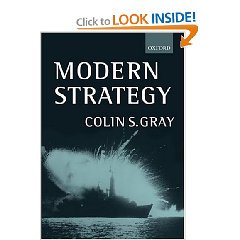First published in 1999, this is an original tour d-horizon that is essential to any discussion of the theory and practice of conflict in the 21st Century, to include all those discussions of the alleged Revolution in Military Affairs (RMA), the need for “defense transformation”, and the changing nature of civil-military relations.
I am much impressed by this book and the decades of thinking that have gone into it, and will outline below a few of its many signal contributions to the rather important questions of how one must devise and manage national power in an increasingly complex world.
First, the author is quite clear on the point that technology does not a revolution make-nor can technology dominate a national strategy. If anything-and he cites Luttwak, among others, with great regard-an excessive emphasis on technology will be very expensive, susceptible to asymmetric attack, and subversive of other elements of the national strategy that must be managed in harmony. People matter most.
Second, and this is the point that hit me hardest, it is clear that security strategy requires a holistic approach and the rather renaissance capability of managing a multiplicity of capabilities-diplomatic, economic, cultural, military, psychological, information-in a balanced manner and under the over-arching umbrella of a strategy.
Third, and consistent with the second, “war proper” is not exclusively about force of arms, but rather about achieving the national political objective by imposing one's will on another. Those that would skew their net assessments and force structure capabilities toward “real war” writ in their conventional terms are demeaning Clausewitz rather than honoring him.
Fourth, as I contemplate in this and other readings how best to achieve lasting peace and prosperity, I see implicit in all that the author puts forward, but especially in a quote from Donald Kegan, the raw fact that it is not enough for America to have a preponderance of the traditional military and economic power in the world-we must also accept the burden and responsibility of preserving the peace and responding to the complex emergencies around the globe that must inevitably undermine our stability and prosperity at home.
Fifth, it is noteworthy that of all the dimensions of strategy that are brought forward, one-time-is unique for being unimprovable. Use it or lose it. Time is a strategic dimension too little understood and consequently too little valued by Americans in particular and the Western alliance in general.
Sixth, it merits comment that the author, perhaps the greatest authority on Clausewitz in this era, clarifies the fact that the “trinity” is less about people, government, and an army, than about primordial violence, hatred, and enmity (the people); chance and probability on the battlefield, most akin to a game of cards (the army); and instrumental rationality (the government)-and that these are not fixed isolated elements, but interpenetrate one another and interact in changing ways over time and space.
Seventh, the author devotes an entire chapter to “Strategic Culture as Context” and this is most helpful, particularly in so far as it brings forward the weakness of the American strategic culture, notably a pre-disposition to isolationism and to technical solutions in the abstract. Perhaps more importantly, a good strategic culture with inferior weapons can defeat a weak strategic culture with an abundance of technology and economic power.
Eighth, and finally, the author courageously takes on the issue of small wars and other savage violence, seeking to demonstrate that grand strategy applies equally well to the savage criminal and warlord parasites that Ralph Peters has noted are not susceptible to our traditional legal and military conventions. While he does not succeed (and notes in passing that Clausewitz's own largest weakness was a failure to catalogue the enemy and the dialog with the enemy as a major factor in strategic success and failure), the coverage is acceptable in making three key points:
1) small wars and sub-national conflicts are generally not resolved decisively at the irregular level-conventional forces are required at some point;
2) special operations forces have a role to play but lack a strategic context (that is to say, current political and military leaders have no appreciation for the strategic value of special operations forces); and
3) small wars and non-traditional threats-asymmetrical threats-must be taken seriously and co-equally with symmetrical regular conflicts.
At the end of the day, this erudite scholar finds common cause with gutter warrior Ralph Peters and gang-warfare iconoclast Martin Van Crevald by concluding his book with a quote from Alexander Solzhenitsyn: “In the Computer Age we will live by the law of the Stone Age: the man with the bigger club is right. But we pretend this isn't so. We don't notice or even suspect it-why surely our morality progresses together with our civilization.”
See also (and also my lists):
The Search for Security: A U.S. Grand Strategy for the Twenty-First Century
Beyond Declaring Victory and Coming Home: The Challenges of Peace and Stability Operations
Security Studies for the 21st Century
War, Peace, and Victory Strategy and Statecraft for The Next Century
Strategy: Process, Content, Context: An International Perspective
War and Peace and War: The Life Cycles of Imperial Nations
Strategy: The Logic of War and Peace, Revised and Enlarged Edition
Race to the Swift: Thoughts on Twenty-First Century Warfare (International Series on Materials Science and Technology)
On Strategy: A Critical Analysis of the Vietnam War
The Systems View of the World: A Holistic Vision for Our Time (Advances in Systems Theory, Complexity, and the Human Sciences)





